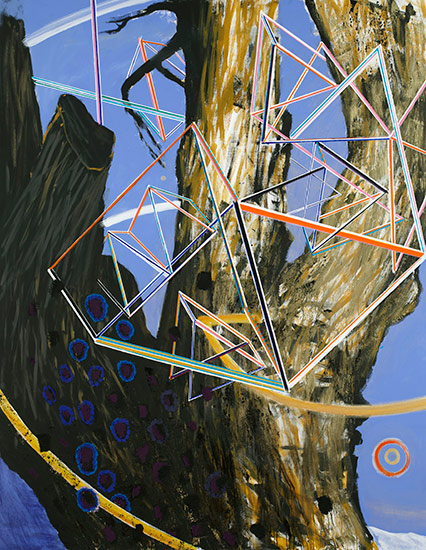Born in Beirut in 1949, Nahas spent his early years between Cairo and Beirut. Both his parents are Lebanese and his father was born in Cairo. This connection to Lebanon and Egypt further strengthened his ties to the region and its culture. In 1960, the Nahas family settled permanently in Beirut and eight years later, in 1968, Nabil Nahas went to the US to study.
“I wanted to go [straight] to New York but my parents were scared. I have an aunt in New Orleans so that’s where I went.
I did my Bachelor’s at Louisiana State University.” After two years in Louisiana, Nahas moved to New Haven to pursue a Master’s degree in Fine Art at the prestigious Yale University School of Art.
His experience there proved to be life-changing. Big-name artists like Chuck Close, Alex Katz, and Frank Stella would visit the class and talk to Nahas and his grad school colleagues about art, technique, inspiration, and life as a working artist. Such intimate access to iconic artists sent Nahas reeling with ambition and hope. “We were now familiar with all those [artists]. [They] weren’t myths anymore, they were human beings like you and me. It made the concept of succeeding in the art world entirely possible.” In 1973, Nahas moved to New York where his arts contacts from Yale opened many doors. “It was a lucky happening,” he says. Another stroke of luck for Nahas was moving to an affordable New York City. Thirty-eight years ago, he settled into an apartment in Tribeca and has been living there ever since. “When I moved here, it was the cheapest thing I could find and now it’s the chicest area!” Nahas laughs.
While at Yale, Nahas studied under the American Abstract Expressionist painter Al Held, whose style would greatly influence the young Nahas. In fact, mid-century Abstract painting was an important visual source for Nahas from the very start of his art education. “When I was 12 or 13 years old, I got a Skira book by Nello Ponente called Modern Painting: Contemporary Trends 1940-1960. It was a survey of all the important Abstract paintings in Europe and America. What I saw in that book was like a treasure trove to me and I decided I wanted to study in America.” His affinity for American Abstract Expressionists is such that many have drawn comparisons between his style and that of Jackson Pollock’s.
At first glance, the similarities are evident: both painters create large-scale works that contain overall fractal patterning.
The viewer is willed by the painter to pause in order to take it all in; a hurried look simply does not suffice. However, Nahas believes that that is where the similarities end between him and Pollock. “The ceilings at Alhambra are amazing and when you look at a Jackson Pollock painting [you see] there are a lot of similarities, it becomes cosmic and never ends. The only similarity between Pollock and I is that we cover the whole canvas. But that doesn’t come out of Pollock, it comes more out of Islamic art.” What Nahas finds so appealing in Islamic art is its open-ended character.
“Arabic music is open-ended and visually [art of the region] is as well.” He counts Sufi aesthetics and fractal geometry as informing his infinitely repeating patterns. “I didn’t [create repetition] through calligraphy, which I find way too easy.” His technique is also based on revisiting the same thing over and over again. Nahas often works on the same painting for a year, going back to the canvas and adding layers of complexity onto it. “There’s an overload of information, it’s difficult for the viewer,” he admits. While aspects of his work may appear chaotic, everything is methodical and based on a strong technique. In fact, it was while experimenting with different painting techniques that Nahas discovered the magic of mixing crushed pumice stone with acrylic paint. The combination created a thick paste which he then slowly brushes onto the canvas. The use of natural stone in his paintings is indicative of his steadfast study of everything that comes from the earth. Nature is everywhere in his paintings from colour and form to subject matter and technique.




























